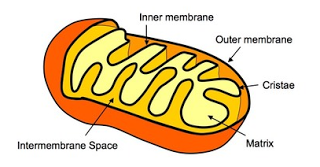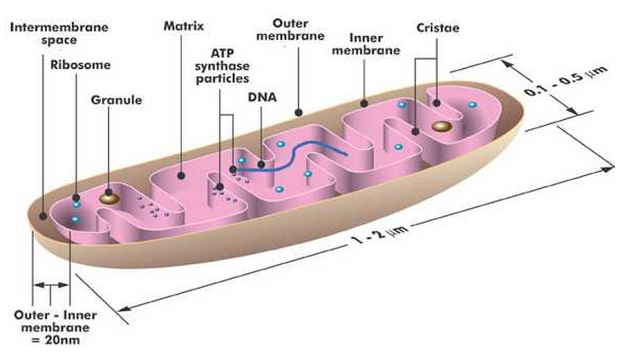Biology

The mitochondrion is a power plant and industrial park of the cell where energy stored in the bonds of carbohydrates is converted to a form more useful to the cell (ATP) and certain essential biochemical conversions of amino acids and fatty acids occur.
Structure
Mitochondria is about 1 mm in diameter and 1-10 mm in length. Mitochondria have dynamic structures that move, change their shape and divide.

Source: Tutor Vista.
- Structure And Functions Of Organelles
The nucleus is bound by two membranes known as the nuclear envelope, which has perforations called nuclear pores. Chromatin within the nucleus condenses to form chromosomes during cell division. The nucleus controls all cellular activity. During mitosis,...
- Q: Describe The Role Of Nad In Aerobic Respiration
NAD is a coenzyme and an electron carrier, it acts as an electron acceptor in glycolysis and Krebs cycle through dehydrogenation processes and is then reduced to NADH. WHen it is reduced to NADH, it is utilized as an electron donor during oxidative phosphorylation....
- #97 Summary Of Energy And Respiration
1 Organisms must do work to stay alive. The energy input necessary for this work is either light, for photosynthesis, or the chemical potential energy of organic molecules. Work includes anabolic reactions, active transport and movement. Some organisms,...
- #85 Energy And Respiration - Syllabus 2016
12.1 Energy12.2 Respiration Energy is a fundamental concept in biology. All living things require a source of cellular energy to drive their various activities. ATP is the universal energy currency as its molecules are small,...
- Photosynthesis And Cellular Respiration
Photosynthesis is the processes of converting carbon dioxide and water, using light energy, into glucose and oxygen. Plants, algae, and certain prokaryotes capture about 1% of the energy in the sunlight that reaches Earth and convert it to chemical energy...
Biology
#94 Structure and function of the mitochondrion

The mitochondrion is a power plant and industrial park of the cell where energy stored in the bonds of carbohydrates is converted to a form more useful to the cell (ATP) and certain essential biochemical conversions of amino acids and fatty acids occur.
Structure
Mitochondria is about 1 mm in diameter and 1-10 mm in length. Mitochondria have dynamic structures that move, change their shape and divide.
- Enclosed by two membranes that have proteins embedded in phospholipid bilayers
- Outer membrane is smooth and highly permeable to small solutes, but it blocks passage of proteins and other macromolecules
- Inner membrane is convoluted and contains embedded enzymes that are involved in cellular respiration. The membrane' have many infoldings called cristae which increase the surface area available for these reactions to occur.
- The inner and outer membranes of mitochondria divide it into two internal compartments: inntermembrane space is the narrow region between the inner and outer mitochondrial membranes.
- Tt resembles the solute composition of the cytosol,because the outer membrane is permeable to small solute molecules.
- Mitochondrial matrix is the compartment enclosed by the inner mitochondrial membrane
- Tt contains enzymes that catalyze many metabolic steps of cellular respiration
- Some respiratory enzymes are embedded in the inner membrane.

Functions of Mitochondria
- The major function of the mitochondria is to produce energy. The energy giving food molecule are sent to the mitochondrion where they are further precessed to produce charged molecules that combine with oxygen and produce ATP molecules. This total process is known as oxidative phosphorylation.
- NADH and FADH2 from glycolysis, pyruvate oxidation, and the citric acid cycle are oxidized by the respiratory chain, regenerating NAD+ and FAD. Most of the enzymes and other electron carriers of the chain are part of the inner mitochondrial membrane. Oxygen (O2) is the final acceptor of electrons and protons, forming water (H2O).
- A Chemiosmotic Mechanism Produces ATP As electrons pass through the series of protein complexes in the respiratory chain, protons are pumped from the mitochondrial matrix into the intermembrane space.As the protons return to the matrix through ATP synthase, ATP is formed.
Syllabus: 12.2 Respiration i) describe the relationship between structure and function of the mitochondrion using diagrams and electron micrographs |
- Structure And Functions Of Organelles
The nucleus is bound by two membranes known as the nuclear envelope, which has perforations called nuclear pores. Chromatin within the nucleus condenses to form chromosomes during cell division. The nucleus controls all cellular activity. During mitosis,...
- Q: Describe The Role Of Nad In Aerobic Respiration
NAD is a coenzyme and an electron carrier, it acts as an electron acceptor in glycolysis and Krebs cycle through dehydrogenation processes and is then reduced to NADH. WHen it is reduced to NADH, it is utilized as an electron donor during oxidative phosphorylation....
- #97 Summary Of Energy And Respiration
1 Organisms must do work to stay alive. The energy input necessary for this work is either light, for photosynthesis, or the chemical potential energy of organic molecules. Work includes anabolic reactions, active transport and movement. Some organisms,...
- #85 Energy And Respiration - Syllabus 2016
12.1 Energy12.2 Respiration Energy is a fundamental concept in biology. All living things require a source of cellular energy to drive their various activities. ATP is the universal energy currency as its molecules are small,...
- Photosynthesis And Cellular Respiration
Photosynthesis is the processes of converting carbon dioxide and water, using light energy, into glucose and oxygen. Plants, algae, and certain prokaryotes capture about 1% of the energy in the sunlight that reaches Earth and convert it to chemical energy...
